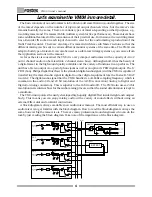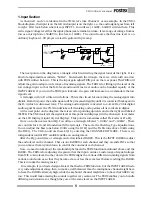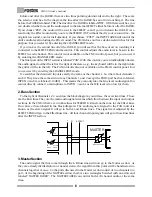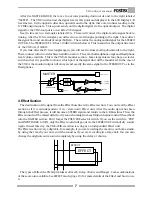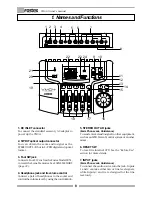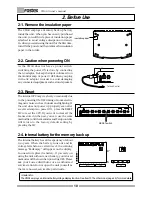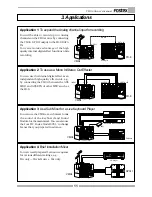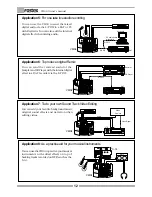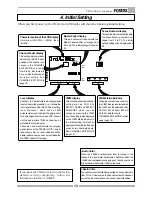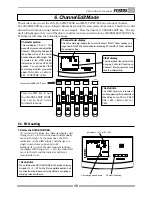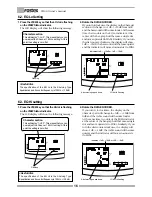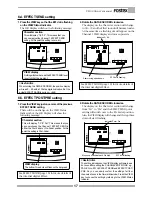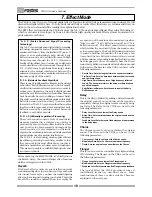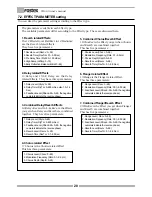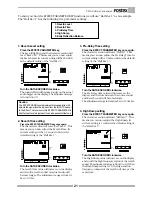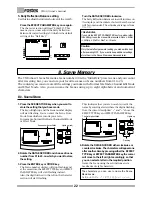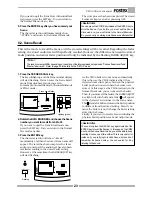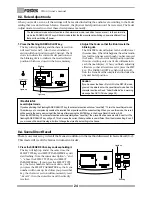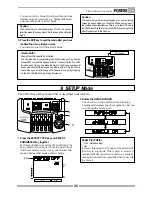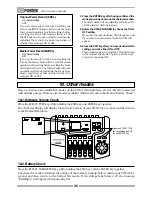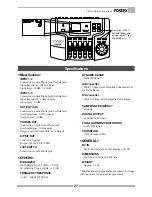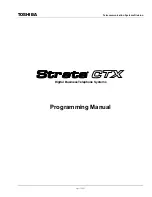
18
VM04 Owner’s manual
7. Effect Mode
The VM04 carries 20 types of internal digital effects. You can also alter their parameter settings in detail. We will
discuss the digital effects here. To fully understand their versatile effect functions, we recommend that you
listen to the actual sound while reading the explanations below.
The DSP effect section inside the VM04 employs the A.S. P. (Fostex Advanced Signal Processing Technology)*,
which is exclusively developed by Fostex, and obtains high quality ambient effects almost equivalent to a
professional reverb unit.
*A. S. P. (Fostex Advanced Signal Processing
Technology)
The A. S. P. is an exclusive new digital effect processing
technology designed by Fostex. This method extracts
maximum efficiency from the limited DSP power. It
achieves an overwhelmingly high density Early
Reflection sound and wonderfully smooth High
Dump response through the H. F. A. (Harmonic
Feedback Algorithm). Also, it carries out an elaborate
reverb simulation with clear sounds through the H.
D. L. P. (Hi-Density Logarithmic Processing), which
eliminates the mutual interference between the
numerous integrated delay modules and reduce the
impurity and grit of the sound.
*H. F. A. (Harmonic Feedback Algorithm)
There is one of indispensable elements in the natural
echo called “Early Reflection sound”, which is usually
sacrificed in commercial reverb products in order to
reduce costs. (In practice, the Early Reflection sound
means the very first reverberated sound that bounces
back from walls, floors and ceilings of concert halls).
The entire reverb sound quality depends on this Early
Reflection sound and how closely it can resemble
the real echo. The H. F. A. is an algorithm that enables
the effect unit to reproduce a clear and natural Early
Reflection sound by applying an ideal harmonic
feedback to each delay module.
*H. D. L. P. (Hi-Density Logarithmic Processing)
The reverb sounds consist of lots of small delay
elements combined in a complex way, which are
produced by many delay modules inside the effect
unit. In order to obtain smooth and comfortable
reverb sounds, it is very important to efficiently
organize the relationship between each delay module
and minimize negative mutual interference.
The H. D. L. P. is a technology which applies efficient
logarithmic processing to each delay module, so that
they can work in the most efficient way in order to
eliminate harmful reverb elements and roughness.
This makes it possible to establish high density and
transparent sounds.
Before operating the EFFECT MODE, let’s briefly discuss
the Reverb, Delay, Chorus and Flanger effect functions
which are integrated in the VM04.
Reverb
The Reverb effect consists of various reflection (echo)
sounds mixed together. Just as when you clap your hands
in a tunnel, for example, you hear the sound lingering
after you have stopped clapping your hands. This is the
Reverb. The sounds we normally hear in everyday life
are made up of three kinds of sound mixed together:
“Direct sound”, “Early Reflection sound” and “Late
Reflection sound”. The Direct sound refers to sound
which reaches the ears directly from the sound source,
as the name suggests. The Early Reflection sound refers
to sound which has rebounded off a wall only a few
times. And the Late Reflection sound refers to sound
which continues rebounding long after the Direct sound
has disappeared. Our ears normally hear the Direct
sound, Early Reflection sound and Late Reflection sound
in that order. The Reverb on the VM04 can be set to the
following parameters:
* Reverb Time: Sets the length of time the sound reverberates.
* Pre-Delay Time: Sets the time lapse between the direct sound
and the reverb sound.
* High Dump: Sets the decay rate of high frequency reflected
sound. The decay rate refers to the amount of time it takes a
sound to disappear.
* Early Reflection Balance: Sets the audio level of the Early
Reflection sound.
Delay
This is the effect obtained by adding a delayed sound to
the original sound. You can obtain a richer sound or
completely change the original source sound by using
the Delay. The Delay on the VM04 can be set to the
following parameters:
* Delay Level: Sets the volume of the Delay sound.
* Delay Time: Sets the time between the original sound and the
delay sound.
* Feedback Level: Sets the level of the delay sound to be returned
to the delay input.
Chorus
The Chorus is used to widen or thicken the original
sound. The Chorus on the VM04 can be set to the
following parameters:
* Chorus Level: Sets the volume of the Chorus sound.
* Modulation Rate: Sets the Chorus modulation frequency.
* Depth: Sets the depth of sound available on the Chorus.
Flanger
This is to use to create a sound like a jet airplane taking
off or landing. The Flanger on the VM04 can be set to
the following parameters:
* Flange Level: Sets the volume of the Flanger sound.
* Modulation Rate: Sets the Flanger modulation frequency.
* Feedback Level: Sets the volume of the Flanger sound feedback.
The type of Effect the VM04 provides can be set
individually in the way described above. Some
combinations of these are also available. These are
explained on the next page.

